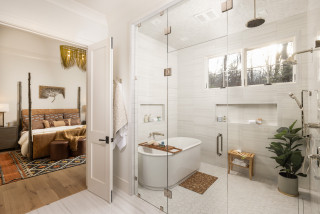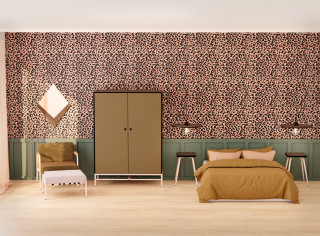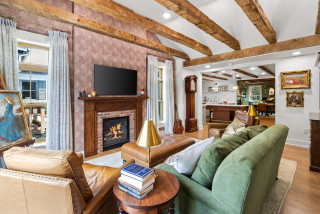
This article was originally published by a www.houzz.com . Read the Original article here. .

Pixa chair by Hugo Charlet
3. Uncurved Seating
Although chairs have been adopting comforting, wraparound shapes with domed curves for a few years, this fair saw the return of sharp, straight lines. That’s one of the things we noticed in creations by young designers, including Hugo Charlet, the young graduate selected by Paris Design Week Factory to showcase his designs for the first time.
The initiative chose to put the spotlight on his Pixa collection, a line of robust, rustic furniture designed for outdoor spaces. Their thick legs and oversized proportions are intriguing, but the manufacturing method also deserves attention. The collection is designed using a unique type of board made from pressure-treated pine for optimal resistance, making manufacturing as straightforward as possible while minimizing off-cuts and waste.
This article was originally published by a www.houzz.com . Read the Original article here. .

Pixa chair by Hugo Charlet
3. Uncurved Seating
Although chairs have been adopting comforting, wraparound shapes with domed curves for a few years, this fair saw the return of sharp, straight lines. That’s one of the things we noticed in creations by young designers, including Hugo Charlet, the young graduate selected by Paris Design Week Factory to showcase his designs for the first time.
The initiative chose to put the spotlight on his Pixa collection, a line of robust, rustic furniture designed for outdoor spaces. Their thick legs and oversized proportions are intriguing, but the manufacturing method also deserves attention. The collection is designed using a unique type of board made from pressure-treated pine for optimal resistance, making manufacturing as straightforward as possible while minimizing off-cuts and waste.
This article was originally published by a www.houzz.com . Read the Original article here. .

Curves are making a strong comeback, whether in furniture, cabinetry, tile or mirrors. Fluted finishes, curved sofas and bubble silhouettes soften hard angles, add sculptural interest and create a sense of calm. These rounded forms also bring visual flow and comfort.
“Furniture and decor are taking on more sculptural shapes,” designer Whitney Ray of Wyeth Ray Interiors says. “From curved sofas to asymmetrical mirrors and stone tables with softened edges, these forms add visual interest while evoking a sense of calm and connection to nature. This trend bridges art and function, often blurring the line between furniture and sculpture.”
In this Los Angeles living room by Mark Design, curvy furniture, organic-shaped mirrors, a ribbed coffee table and arched console accessories highlight the trend. The shapes, palette and boucle sofa fabric also contribute to the room’s organic modern style.
This article was originally published by a www.houzz.com . Read the Original article here. .
Remote work may no longer dominate the U.S. labor force as it did during the height of the pandemic in 2020, but it still represents a substantial share of employment today. According to the latest data from the Current Population Survey (CPS), approximately 34.3 million employed people teleworked or worked at home for pay in April 2025. The telework rate, which represents the number of people who teleworked as a percentage of people who were working, was 21.6% in April, and it has consistently ranged between 17.9% and 23.8% between October 2022 and April 2025.
Of those who teleworked in April, more than half teleworked for all their working hours, while the remaining teleworked for some, but not all, of their work hours.
The distribution of telework across the U.S. workforce continues to reflect deeper patterns shaped by gender, age, education, occupation, and industry. The following insights are based on an analysis of monthly CPS data.
Gender: Women Lead in Telework
Women continue to outpace men in remote work participation.
Nearly 25% of employed women worked from home in April 2025.
In contrast, about 19% of employed men teleworked.
This gender gap reflects employment trends. Many women are employed in professional, administrative, or office-based roles. These fields transitioned smoothly to remote work during the pandemic and have largely maintained hybrid or fully remote options. Additionally, the growing rate of college completion among women1 has pushed more women into positions that are structurally suited to telework. Flexibility remains a priority, especially for women balancing work and caregiving responsibilities, further reinforcing the demand for work-from-home arrangements.
Age: Older Workers Are More Likely to Telework
Age also plays a major role in who works remotely. Workers aged 25 and older are more likely to telework than their younger counterparts.
Ages 16–24: Only 6.2% worked from home.
Ages 25–54: About 24% reported teleworking.
Ages 55+: Around 23% worked remotely.
Younger workers tend to fill entry-level roles in retail, hospitality, and service sectors that require in-person attendance. Meanwhile, older workers are more likely to have progressed in their careers into managerial or specialized roles where remote work is feasible or even expected.
Education: Higher Degrees, Higher Telework Rates
Education remains one of the strongest indicators of telework status. Higher educational attainment is positively associated with a higher telework rate.
No high school diploma: Just 3.1% worked remotely.
High school graduates, no college: 8.4% teleworked.
Some college or associate degree: 17.3% reported working from home.
Bachelor’s degree or higher: 38.3% worked remotely.
Higher educational attainment often leads to employment in knowledge-based sectors such as finance, information technology, consulting, and research. These roles often depend on digital communication tools and independent project-based tasks, making them well-suited for remote settings.
Occupation: Business and Financial Operations, and Professionals Dominate Remote Work
Not surprisingly, occupation heavily influences access to teleworking. Jobs that require physical presence, such as those in food service, transportation, manufacturing, and construction, naturally offer limited remote opportunities. In contrast, people employed in professional and technical fields report the highest telework rate, especially those working in computer and mathematical roles.
Industry trends mirror these occupational divisions. Certain sectors have fully embraced telework, particularly finance, information services, and professional and business services. These industries often prioritize flexibility and are structured in ways that make remote work not only possible but efficient. On the other hand, industries like construction, leisure and hospitality remain firmly grounded in physical spaces and in-person involvement. In these fields, work is inherently tied to locations and equipment that cannot be replicated remotely. The construction industry had a telework rate of just 9.8% in April, and leisure and hospitality reported an even lower rate of 8.1%.
Looking Ahead:
Remote work is not disappearing; it is evolving. The opportunity to work from home is increasingly concentrated among individuals with higher education levels, white-collar job titles, and positions in tech-driven or office-based industries. Meanwhile, those who are younger, have less educational attainments, or work in manual or service-based roles remain largely tied to traditional, in-person work.
For the future, we don’t know if telework will expand to become more inclusive or continue reinforcing existing divides in education and job roles. For now, the data suggests that remote work is here to stay, but only for some.
Note:
“U.S. women are outpacing men in college completion, including in every major racial and ethnic group”, Pew Research Center.
Connor Borkowski and Rifat Kaynas, “Telework trends,” Beyond the Numbers: Employment & Unemployment, vol. 14, no. 2 (U.S. Bureau of Labor Statistics, March 2025),
Discover more from Eye On Housing
Subscribe to get the latest posts sent to your email.
This article was originally published by a eyeonhousing.org . Read the Original article here. .

Bringing some of the health benefits of the wilderness to busy urban lives was another trend seen across the show. The most striking example of this was the Fettercairn Wilderness Retreat balcony garden (pictured) by ssh scapes — Sonia Kamel, Sally Giles and Helier Bowling — and inspired by the wild landscape of the Scottish Cairngorms mountains.
This small urban space was designed for a busy professional couple “who love the outdoors and, in particular, the Cairngorms in Scotland, and want to recreate the environment for daily health benefits on their high-rise city balcony,” according to the RHS.
At the heart of the space was a copper bath perfect for a cold-water dip, which was surrounded by wild planting reminiscent of the grassy heaths, rocky outcrops and mossy glens typical of the area.
Shop for outdoor products
This article was originally published by a www.houzz.com . Read the Original article here. .

So we reviewed search terms on Houzz from January through March 2025 and compared them with searches from the same period last year to see how homeowner preferences might be changing. The results, highlighted below from the 2025 U.S. Houzz Emerging Summer Trends Report, show rising interest in French country style, wood elements, warm metal accents and other design inspiration worth searching for.
This article was originally published by a www.houzz.com . Read the Original article here. .
NAHB’s analysis of Census Data from the Quarterly Starts and Completions by Purpose and Design survey indicates flat year-over year growth for custom home builders. The custom building market is less sensitive to the interest rate cycle than other forms of home building but is more sensitive to changes in household wealth and stock prices.
There were 34,000 total custom building starts during the first quarter of 2025. This was unchanged relative to the first quarter of 2024. Over the last four quarters, custom housing starts totaled 181,000 homes, just more than a 2% increase compared to the prior four quarter total (177,000).
Currently, the market share of custom home building, based on a one-year moving average, is approximately 18% of total single-family starts. This is down from a prior cycle peak of 31.5% set during the second quarter of 2009 and the 21% recent peak rate at the beginning of 2023, after which spec home building gained market share.
Note that this definition of custom home building does not include homes intended for sale, so the analysis in this post uses a narrow definition of the sector. It represents home construction undertaken on a contract basis for which the builder does not hold tax basis in the structure during construction.
Discover more from Eye On Housing
Subscribe to get the latest posts sent to your email.
This article was originally published by a eyeonhousing.org . Read the Original article here. .

Natural stone is a perennially important material in furnishings and lighting, but it’s become a focal point over the last few seasons as it’s gotten warmer, darker and more heavily veined. Indeed, we once again saw myriad sculptural lamps with colorful marble bases throughout the market.
One of the most popular stones this season, though, fell on the other side of the color spectrum: alabaster. The almost translucent, ethereal off-white stone casts a soft, ambient glow when backlit. Among the standout examples of stone fixtures this spring was this Regina Andrew Bonnie uplight.
This article was originally published by a www.houzz.com . Read the Original article here. .

Renovating homeowners invested in products with both standard and smart technology in 2024, and in fact preferred smart tech in several product categories. The dark green bars in this graphic represent standard products. The light green shows smart products, which refers to technology that can be monitored or controlled from a mobile device (smartphone or tablet), a computer or both.
Light fixtures topped the list of indoor product purchases at 51%, with 38% of renovating homeowners choosing standard and 13% opting for smart versions. TVs followed at 27%, with 16% choosing standard TVs and 11% opting for smart.
Alarms and detectors (14% standard, 12% smart) and thermostats (7% standard, 16% smart) also were in demand. Smart versions led for wireless doorbell cameras (16%), streaming-media players (10%), home assistants (14%) and garage door openers (8%) as well. And among smart security products, homeowners chose wireless door locks (8%), cameras (9%) and motion or other sensors (5%).
Smart security cameras led outdoor tech purchases at 23%, followed by standard outdoor lighting fixtures at 23% (not shown).
10 Ways to Control the Cost of Your Bathroom Remodel
This article was originally published by a www.houzz.com . Read the Original article here. .
Homeowners are still putting serious money into bathroom remodels, especially bigger projects. The national median spend dipped slightly to $13,000 in 2024 (down from $15,000 in 2023), but major remodels — those for which at least the shower is upgraded — ticked up to $22,000 from $21,000 the year before. Large bathrooms of 100 square feet or more command the highest budgets, with spending holding steady at $25,000.
Keep in mind, economists like to reference the median, or midpoint, figure rather than the average for this kind of data because the average can be skewed, can be volatile year over year and can be misleadingly high or low because of a single project that costs far more or less than others.